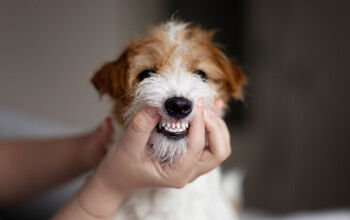Can a Water Additive Keep My Dog's Teeth Clean?

Canine dental disease, ranging from gingivitis to advanced periodontal disease, is sadly common, affecting a large number of adult dogs. It’s a silent threat, often progressing beneath the gum line with no obvious signs until it becomes painful and seriously impacts overall health. In the most severe cases, it can lead to issues in the heart, kidneys, and liver.
While veterinarians agree that daily tooth brushing is the gold standard for preventing plaque and tartar buildup, for some dogs, that feels more like a wrestling match than a bonding experience. If the idea of daily brushing feels overwhelming or impossible for your dog, you may be searching for other options, including the use of dental water additives.
This post will explore how these dental products work, their potential benefits and limitations, and what you should look for when considering one for your dog. By the end, you’ll better understand if a water additive can truly help your dog and if it fits into your greater dental care plan.
Why Dental Health is Important
While that unpleasant “dog breath” may be your first clue that something’s wrong, halitosis (bad breath) is often just the tip of the iceberg when it comes to dental problems in our dogs. The real concern is usually progressing beneath the surface.
It all begins with plaque, a sticky, colorless film that forms on your dog’s teeth and is composed of bacteria, food particles, and saliva. If it isn’t removed, this plaque hardens into tartar. This rough, porous surface provides the ideal environment for bacteria to build up both above and, more concerningly, below the gum line.
This buildup leads to gingivitis, an inflammation of the gums that manifests as redness, swelling, and bleeding. At this early stage, gingivitis is reversible with proper dental care. However, if it’s left untreated, it can progress to periodontal disease, a far more serious condition. Periodontal disease involves the infection and inflammation of the structures that support your dog’s teeth, including the gums, ligaments, and bone. As the infection gets worse, it can lead to irreversible bone loss, gum recession, and ultimately, painful tooth loss.
The impact of poor dental health can also progress beyond just the mouth. The bacteria thriving in an infected mouth don’t stay put; they can enter the bloodstream through inflamed gums and travel throughout the body. This can contribute to serious health issues in vital organs like the heart, kidneys, and liver.
Plus, we must remember that dental disease is incredibly painful for our dogs and life-changing in terms of their overall quality of life. While they often hide their discomfort, dental pain can impact their ability to eat, chew toys, play, and generally enjoy their lives.
This is why vets often emphasize that a healthy mouth is essential for a healthy body.
The Gold Standard: Why Brushing Your Dog’s Teeth is Still Recommended
When it comes to your dog’s dental care, daily tooth brushing stands as the undisputed gold standard. It physically disrupts and removes the sticky plaque and food debris from the tooth surfaces and, most importantly, along the gum line, before the plaque has a chance to harden into tartar. The active scrubbing of brushing is what makes it the most effective solution.
If you’re interested in brushing your dog’s teeth, there are a few things you can do to make the process smoother. Always introduce the toothbrush and toothpaste gradually, focusing on short, positive experiences at first. Make sure you use a toothpaste specifically made for pets, as human toothpaste contains ingredients like xylitol and fluoride that are toxic to dogs. Focus your brushing efforts on the outside surfaces of the teeth, paying close attention to where the tooth meets the gum line, as this is where plaque tends to build up quickest.
Consistency and making tooth brushing a positive, reward-based routine are key to success.
However, we must also face the reality that this isn’t going to work for every dog. Many dogs aren’t comfortable with having their mouths handled this way, leading to resistance, stress, or even fear. Regular, consistent brushing can also be a challenge for pet parents with time constraints in their busy schedules or those who lack the confidence and knowledge necessary to brush effectively.
If daily brushing isn’t feasible for your dog, it doesn’t mean you have to compromise on their dental health. Instead, create a plan with other practical tools to prioritize their dental health and prevent the progression of painful oral diseases.
Enter Water Additives
Given the challenges many pet parents face with daily brushing, an alternative that has been gaining popularity is the use of dental care water additives. Simply put, these are liquid solutions designed to be added directly to your dog’s drinking water, passively improving their oral hygiene with each drink.
How They Work
The active ingredients in the additive target oral bacteria, preventing plaque formation and helping to break down existing plaque before it hardens into tartar. This includes:
- Antimicrobial agents like chlorhexidine, zinc salts, or cetylpyridinium. These compounds help stop the growth of bacteria in the mouth, reducing the overall amount of bacteria contributing to plaque formation and bad breath.
- Enzymes such as glucose oxidase and lactoperoxidase function by breaking down components of plaque or creating an unfavorable environment for bacteria to live and grow.
- Plaque-loosening agents like citric acid or specific plant extracts are thought to help prevent plaque from adhering to the tooth's surface and soften existing plaque, making it easier to remove through activities like chewing.
Some products are made to be tasteless, promising your dog won’t even notice the product has been added to the water. Others add a mild flavoring to make it more tempting for dogs, encouraging them to drink more, adding another benefit to their use.
The Advantages of Water Additives
Why are these products so appealing to a growing number of pet parents?
The most significant advantage is their ease of use. There is no need for conditioning your dog to be handled or creating extensive routines. Instead, simply measure and add the recommended amount to your dog’s water bowl and go about your day.
These products also ensure your dog is consistently exposed to the active ingredients throughout the day. This allows the products to work optimally and create a continuous defense against plaque buildup without any downtime for the bacteria to grow and thrive.
Unlike targeted brushing, an ingested product like a water additive can reach all tooth surfaces, even the areas that are often difficult or impossible to access with a traditional toothbrush. They can also contribute to a healthier environment below the gum line, an area you can’t directly address with brushing.
Finally, water additives are a completely non-invasive approach for dogs who are resistant to having their mouths touched. This makes cleaner teeth and fresher breath accessible to all dog parents, not just those who can condition their dog to the toothbrush.
Important Considerations and Limitations
So, if the product is so easy to use and effective in addressing dental health, why is it not considered the gold standard? Water additives are an assistive tool, not a complete replacement for proper brushing, especially when it comes to established tartar. They work well to prevent plaque from forming and hardening, lowering the amount of tartar that develops, but are generally not effective at removing existing, calcified tartar. Brushing can help, but the best approach is to have regular professional dental cleanings under anesthesia by your veterinarian.
A significant hurdle some pet parents face is palatability issues, especially if you have a dog who is particularly sensitive to different tastes. Not only could this limit the product’s effectiveness (it won’t work if they aren’t ingesting it), but it could also turn them off their water dish entirely, putting them at risk for dehydration.
Finally, it’s important to note that water additives are not as strictly regulated by bodies like the FDA in the same way medications are. You should prioritize products that carry the Veterinary Oral Health Council (VOHC) Seal of Acceptance when possible. To earn this seal, they must meet specific standards for effectiveness in reducing plaque or tartar.
Choosing and Using Water Additives Safely and Effectively
Now that you're familiar with the benefits of dental water additives for your dog, the next step is knowing how to select and use them properly. Choosing the right products and learning how to use them will allow you to maximize these benefits while ensuring your pet is safe.
What to Look For
Feeling overwhelmed by all the available options? The first thing to look for, as we already discussed, is the VOHC Seal of Acceptance. This will help you significantly cut down on the options, focusing just on those that have gone through rigorous scientific review and have been proven effective at reducing plaque or tartar buildup.
Next, check the ingredients list. Look for transparency and clarity. If you encounter any unfamiliar components, take the time to research them. After all, we all want to feel confident in the safety of anything we give our pets. Additionally, ensure the product comes with clear, easy-to-follow dosage and mixing instructions to prevent over- or under-dosing.
Opt for products from reputable brands known for their commitment to pet health. If you’re unsure about a product or need additional guidance, consider reaching out to your veterinarian to discuss your options.
Some VOHC-accepted water additives I highly recommend from personal experience include:
- TropiClean Fresh Breath Water Additive for Dogs
- Skout’s Honor Fresher Breath Flavorless Water Additive
- Bluestem Oral Care Water Additive for Cats & Dogs
- Vetradent Water Additive for Dogs & Cats
How to Introduce and Use Water Additives
Introducing any new product to your dog requires a careful approach. Start gradually, with a smaller dose than recommended for the first few days. This will allow your dog time to adjust to any subtle change in taste while also giving their body a chance to adjust, minimizing any gastrointestinal upset from the new product.
During this time, pay careful attention to your dog’s water intake. If you notice they are drinking significantly less or refusing to drink, reduce the amount of additive or try a different brand altogether. There is no one-size-fits-all. The product we use today with our current dogs is different from what we used with our previous pups due to their personal preferences.
Consistency is key for any potential benefits. The additive needs to be present in their water every day. If you’re worried about sticking to a schedule, consider adding a daily reminder on your phone.
Don’t overlook the importance of overall hygiene. Cleaning and disinfecting your dog’s water bowls will prevent bacteria buildup and ensure the additive can work effectively.
The Best Approach to Canine Dental Health
We must recognize there is no single “magic bullet” solution when it comes to our dog’s dental well-being. While dental water additives offer a convenient and effective way to help manage plaque, especially for dogs who resist brushing, the best strategy requires a truly multifaceted approach. Think of it like building a strong wall of defense, one brick at a time.
Complementary Solutions for Oral Care
The best foundation for your dental care approach is regular professional dental cleanings performed under anesthesia by your veterinarian. These cleanings are crucial for safely removing established tartar both above and below the gum line, addressing any subgingival disease that cannot be reached through at-home care. Depending on your dog’s individual needs and the progression of any dental disease, your vet may recommend annual or bi-annual cleanings.
Beyond professional intervention, incorporating VOHC-accepted dental chews and treats can help remove plaque and tartar accumulation between brushing. This is a great complement to a water additive that softens existing plaque.
For some dogs, a prescription dental diet can also be highly beneficial. These specialized kibbles are often formulated with a unique texture and ingredients designed to scrub the teeth clean or inhibit plaque from forming as your dog eats.
Finally, you are the most important tool in your dog’s oral care. Make it a habit to perform regular oral inspections at home, looking for any signs of trouble such as redness, swelling, bleeding gums, chipped or broken teeth, or an unusually foul odor to their breath. Early detection can make a significant difference in managing dental issues.
Partnering with Your Veterinarian
Ultimately, a strong partnership with your veterinarian is essential. Regular vet check-ups provide an opportunity for thorough oral exams. This allows them to detect problems early and provide personalized advice tailored to your dog’s specific needs.
Your vet is the best resource for guiding you through the various dental care options and creating a plan that works for both you and your furry friend. The main goal of this approach is to proactively address dental health from every angle, ensuring your dog experiences the best possible quality of life, free from the pain and health risks associated with untreated dental disease.
Prioritize Your Dog’s Oral Health for a Long, Happy Life
Ultimately, prioritizing your dog’s dental health is an essential part of being a responsible pet parent. While daily tooth brushing remains the gold standard, it’s not always a feasible option for every dog and every household. This is where products like dental water additives shine, offering a convenient and effective tool to help combat plaque and keep breath fresher when used correctly and as part of a broader dental care strategy.
Remember, every effort you make towards your dog’s oral hygiene, no matter how seemingly small, will contribute significantly to their health and comfort. Discuss your dental care plan with your veterinarian for personalized feedback and advice.
By taking these proactive steps, you’re not just preventing bad breath; you’re safeguarding your beloved companion’s health, ensuring they can live a life full of comfort, joy, and healthy smiles for years to come!
Join the PetGuide community. Get the latest pet news and product recommendations by subscribing to our newsletter here.

Britt Kascjak is a proud pet mom, sharing her heart (and her home) with her “pack” which includes her husband John, their 2 dogs – Lucifer and Willow – and their 3 cats – Pippen, Jinx, and Theia. She has been active in the animal rescue community for over 15 years, volunteering, fostering and advocating for organizations across Canada and the US. In her free time, she enjoys traveling around the country camping, hiking, and canoeing with her pets.
More by Britt
























